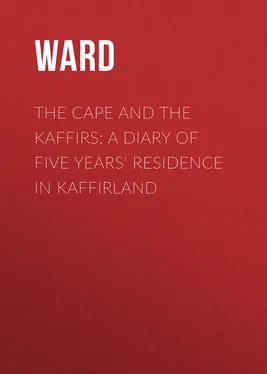Ward - The Cape and the Kaffirs - A Diary of Five Years' Residence in Kaffirland
Здесь есть возможность читать онлайн «Ward - The Cape and the Kaffirs - A Diary of Five Years' Residence in Kaffirland» — ознакомительный отрывок электронной книги совершенно бесплатно, а после прочтения отрывка купить полную версию. В некоторых случаях можно слушать аудио, скачать через торрент в формате fb2 и присутствует краткое содержание. Издательство: Иностранный паблик, Жанр: foreign_prose, История, foreign_edu, foreign_antique, на английском языке. Описание произведения, (предисловие) а так же отзывы посетителей доступны на портале библиотеки ЛибКат.
- Название:The Cape and the Kaffirs: A Diary of Five Years' Residence in Kaffirland
- Автор:
- Издательство:Иностранный паблик
- Жанр:
- Год:неизвестен
- ISBN:нет данных
- Рейтинг книги:4 / 5. Голосов: 1
-
Избранное:Добавить в избранное
- Отзывы:
-
Ваша оценка:
- 80
- 1
- 2
- 3
- 4
- 5
The Cape and the Kaffirs: A Diary of Five Years' Residence in Kaffirland: краткое содержание, описание и аннотация
Предлагаем к чтению аннотацию, описание, краткое содержание или предисловие (зависит от того, что написал сам автор книги «The Cape and the Kaffirs: A Diary of Five Years' Residence in Kaffirland»). Если вы не нашли необходимую информацию о книге — напишите в комментариях, мы постараемся отыскать её.
The Cape and the Kaffirs: A Diary of Five Years' Residence in Kaffirland — читать онлайн ознакомительный отрывок
Ниже представлен текст книги, разбитый по страницам. Система сохранения места последней прочитанной страницы, позволяет с удобством читать онлайн бесплатно книгу «The Cape and the Kaffirs: A Diary of Five Years' Residence in Kaffirland», без необходимости каждый раз заново искать на чём Вы остановились. Поставьте закладку, и сможете в любой момент перейти на страницу, на которой закончили чтение.
Интервал:
Закладка:
“In our Report of the 30th of March last, we pointed out the peculiar position and character of the natives inhabiting the district; it will, therefore, be unnecessary for us to say more on this, than that they are widely different from those on the frontier of the old colony, and are valuable and indispensable assistants to the white settler. We take occasion to make these remarks, because we are of opinion that when the recommendations we have made in our General Report shall have been carried out, the presence of so many natives, most of them available as labourers, should be an inducement to emigrants selecting this district as the land of their adoption, rather than operate prejudicially.
“The future prospects of the district of Natal as a colony, depend very materially, if not exclusively, upon the filling up of the unoccupied intervals of the district with emigrants from the United Kingdom, and the efficient management and control of the native population within it. Its general capabilities, as we have already represented, are of the highest class, either for agricultural or grazing purposes. It contains an area of 18,000 square miles, within which is found every material for improvement and prosperity a colony can be favoured with, and requires but an intelligent white population to develop its immense and fertile resources.
“Building stone of a very good quality is found all over its surface; and in some localities a superior description of free-stone is found in abundance. Iron ore is found in great abundance in the district, and has been used by the natives for their assegais and agricultural implements, and is said to be of a very superior quality.
“The prices realised in England for the first exportation of cotton grown in this district, exhibited under all the disadvantageous circumstances connected with the utter inexperience on the part of the grower, of 7.25 pence per pound, warrants an inference highly favourable to the quality of the article, when it shall have received the treatment that experience has taught to be necessary in cotton-growing countries.
“We are of opinion that this district inhabited by an industrious white population, will produce valuable exports, both in amount and quality, and is capable of maintaining a denser population than the colony of the Cape of Good Hope; and we trust that its resources and advantages may not become lost to the subjects of the British crown, from their not being represented as their high merits appear to us to deserve.
“In this Report,” Mr Stanger remarks, “I shall not enter fully into the geography of the interior of the district, reserving that for a future time, as I shall have a good opportunity of continuing the same kind of observations, and thus fixing more points than at present I have been able to do, during the proposed enquiry as to the location of the natives; but shall describe, as far as I am able, the boundary and extent of the district of Natal.
“The Umzinyati rises at the base of the Draakberg, in latitude 27 degrees 46 minutes and longitude 20 degrees 25 minutes; from this its course is about E.S.E., until it falls into the Utukela (incorrectly called the Tukela.) From all the information I can obtain, (not having yet visited this part of the district) this is below the confluence of the Mooi River and the Utukela, and therefore not very far from the mouth of the latter, which from the maps appears to be in latitude 29 degrees 16 minutes South and longitude 31 degrees 30 minutes East; thus forming the north-eastern boundary of the district.
“The country below the rise of the Umzinyati, and for the distance of about twenty miles, is for the most part flat and undulating, with little or no wood, but covered with sweet grass, and from what I can ascertain is considered a good tract for country sheep.
“The river, when I saw it (in February, 1847), was about sixty yards wide, it being then full of water; below this, and during its whole course, I understand it runs through a broken and thick bushy country.
“The Draakberg, instead of being considered as one continuous chain of mountains, may be more correctly divided into two, of different geological structure, and having different directions: the one forming the north-western boundary I shall call the Great Draakberg; and the other, forming the western boundary, the Small Draakberg.
“The north-western portion of the Draakberg is of the average altitude of five thousand feet above the sea, and about fifteen hundred feet above the general level of the country at its base.
“The outline is in general round and soft, presenting some remarkable features, and occasionally high table-lands with precipitous sides. These mountains are composed of beds of sandstone, cut through by veins of trap, and diminish in height as they advance to the north-east, until at some distance beyond the source of the Umzinyati they appear to terminate in low hills. They are passable almost at any part by horses and cattle; but there are only three passes in use by the Boers, one near Bezuidenhout’s Farm, in latitude 28 degrees 33 minutes South and longitude 28 degrees 44 minutes East; and one at De Beer’s, in latitude 28 degrees 20 minutes South and longitude 28 degrees 52 minutes East, and another a little more to the south-west of Bezuidenhout’s. The two former are in constant use; the latter rarely.
“Timber abounds in the kloofs on the south-eastern side of the mountain. On the north-west the country is much higher, being a plain of great elevation.
“The Great Draakberg, or that portion of it which forms the western boundary, has a direction N.N.W. and S.S.E. The junction of this with the former, or Small Draakberg, is ten or twelve miles to the S.W. of Bezuidenhout’s Pass:—from this part the Utukela rises.
“These mountains are much higher than the others, and are quite impassable, presenting a rugged outline and bold and precipitous escarpments. From a distant view, from the nature of the outline (not having been near them) I infer that they are granitic.
“The area of this district, from the ascertained and assumed boundaries will be much greater than has hitherto been supposed. It cannot, I imagine, be less than 13,500 instead of 10,000 square miles. At the same time it must be remembered, that if I find by my future observations, (which I think will very probably be the case) the same amount of error, and in the same direction in the southern portion of the district, of which at present I know nothing, as I have found in the northern, the area will be increased by a great quantity, and may not fall far short of 16,000 square miles, as a small deviation in the assigned direction of the Great Draakberg will easily make that quantity.
“The district is everywhere covered with vegetation, either in the form of luxuriant grass, which grows to a great height, or thorns and low bushes. Timber trees only grow in kloofs on sides of hills, excepting a belt which runs along the sea-coast.
“Water abounds in every part, and flowing streams cross the path at intervals of only a few miles. In the winter some of these become dry, but then water may always be obtained at moderate distances.
“The soil is in all cases well adapted for cultivation, and on the alluvial lands near rivers particularly so, producing much larger crops than are ever grown in the Colony of the Cape of Good Hope.
“The rocks which occur in the district, as far as I have yet seen, are granite, basalt, and members of the trap family, slate, sandstone, and shale.
“Coal containing but little bituminous matter occurs in in beds in the sandstone. In a kloof near the drift of the Bushman’s River, there is a bed nine inches thick. This is the nearest locality I am aware of to Pietermaritzburg; it is distant about sixty-three miles. It is more abundant to the north-west, and I observed it in a small river near Biggar’s Berg, in about latitude 28 degrees 7 minutes South, and longitude 29 degrees 25 minutes East, in a bed six feet thick, and of good quality; it is here cut through by a vein of trap.”
Читать дальшеИнтервал:
Закладка:
Похожие книги на «The Cape and the Kaffirs: A Diary of Five Years' Residence in Kaffirland»
Представляем Вашему вниманию похожие книги на «The Cape and the Kaffirs: A Diary of Five Years' Residence in Kaffirland» списком для выбора. Мы отобрали схожую по названию и смыслу литературу в надежде предоставить читателям больше вариантов отыскать новые, интересные, ещё непрочитанные произведения.
Обсуждение, отзывы о книге «The Cape and the Kaffirs: A Diary of Five Years' Residence in Kaffirland» и просто собственные мнения читателей. Оставьте ваши комментарии, напишите, что Вы думаете о произведении, его смысле или главных героях. Укажите что конкретно понравилось, а что нет, и почему Вы так считаете.












